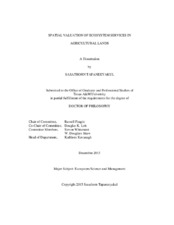| dc.description.abstract | Agricultural lands provide various provisioning ecosystem services to humans, including food, water, fibers, fuel, and components of pharmaceuticals. These ecosystems also support and regulate such services as pollination, water provision, and the retention of nutrients and soil. The value of these ecosystem services, while tremendous, historically has been vaguely defined and underappreciated.
This research built a comprehensive framework to spatially map and quantify the ecosystem services provided by agricultural lands in Galveston County, Texas using an open-source ecosystem services modeling tool called the Integrated Valuation of Ecosystem Services and Tradeoffs (InVEST) models. Five ecosystem services models were investigated, including: water yield, nutrient retention, sediment retention, pollination abundance, and habitat quality. Biophysical data, such as land use/land cover, precipitation, evapotranspiration, soil and pollinator characteristics, and threats to habitat were input into the InVEST models to determine the amounts and spatial patterns of these ecosystem services. Results showed spatially distributed ecosystem services throughout the study area, with hot spots of ecosystem services where certain activities were concentrated, such as streams, croplands, and intensely developed lands. A hedonic price model was designed to appraise the value of these ecosystem services based on the prices of the agricultural land as well as other relevant factors (neighborhood, structure, and market segmentation). The model was used to estimate the marginal implicit price of a per unit increase in each ecosystem services variable.
The estimates suggested that ecosystem services were included in appraisals of the land prices – to various degrees of statistically significant correlation – except with regards to pollination abundance and habitat quality. The habitat degradation value, a derivative of the habitat quality model, was shown to be most closely correlated with land prices, which could be explained by highly degraded lands as a result of extensive cropping systems.
Together, this suggests that more planning, thoughtful policy making, and resource management could help avoid land degradation and prolonged effects that could potentially deplete more resources and habitats within (and beyond) these areas. Further model calibrations that include comparisons of different scenarios (e.g. a baseline scenario, constrained development, and non-constrained development) to manage these lands would help determine efficient steps forward, as accounting for the economic value of ecosystem services is now vital for managing and sustaining our irreplaceable natural resources. | en |


